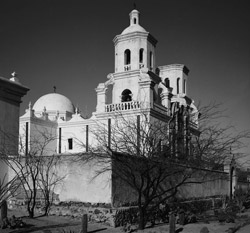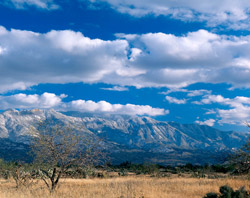|
|
City Snapshot: City of Tucson
 The host of the 2011 League Annual Conference, the city of Tucson has a rich and colorful history. It celebrates a diversity of cultures, architecture, and
people. At the same time, it is one of the "Mega-Trend" cities of the 21st Century: the Optics Valley, premier health services center for the Southwest, the
astronomy center of the world, home of a premier research institution - University of Arizona, and a tourism destination.
The host of the 2011 League Annual Conference, the city of Tucson has a rich and colorful history. It celebrates a diversity of cultures, architecture, and
people. At the same time, it is one of the "Mega-Trend" cities of the 21st Century: the Optics Valley, premier health services center for the Southwest, the
astronomy center of the world, home of a premier research institution - University of Arizona, and a tourism destination.
Tucson, too SAHN or TOO sahn, is one of the oldest towns in the United States. Tucson was originally an Indian village called Stook-zone,
meaning water at the foot of Black Mountain.
 On August 20, 1775, a parcel of land in southern Arizona was selected as the site for the Presidio, a walled Spanish and Mexican military settlement. The claim
was made for the northernmost frontier of "New Spain." The new presidio included a village on the Santa Cruz River, Chukshon, a Native American name meaning
"the spring at the base of the black mountain."
On August 20, 1775, a parcel of land in southern Arizona was selected as the site for the Presidio, a walled Spanish and Mexican military settlement. The claim
was made for the northernmost frontier of "New Spain." The new presidio included a village on the Santa Cruz River, Chukshon, a Native American name meaning
"the spring at the base of the black mountain."
Though this area had been continuously inhabited for more than 12,000 years - one of the oldest in North America - the proclamation of the Presidio marked the
emergence of what would become Tucson: a modern, metropolitan community of nearly one million people that still retains the friendly, caring atmosphere of a
small town.
Tucson was first incorporated as a city on Feb. 7, 1877, and became a charter city on March 7, 1883. Its charter was ratified and approved by the governor in
1929, establishing a mayor and council/city manager form of government that continues to this day.
 Tucson is home to the historic Mission San Xavier del Bac, an international Gem and Mineral Show, the world-famous El Tour de Tucson Bicycle Classic, the
renowned Arizona-Sonora Desert Museum, the world's longest non-mechanized Rodeo Parade, and one of the federal government's most scenic drives in the nation:
the Catalina Highway to Mount Lemmon. The city is also home to the University of Arizona and Davis-Monthan Air Force Base. Industries include electronics and
missile production.
Tucson is home to the historic Mission San Xavier del Bac, an international Gem and Mineral Show, the world-famous El Tour de Tucson Bicycle Classic, the
renowned Arizona-Sonora Desert Museum, the world's longest non-mechanized Rodeo Parade, and one of the federal government's most scenic drives in the nation:
the Catalina Highway to Mount Lemmon. The city is also home to the University of Arizona and Davis-Monthan Air Force Base. Industries include electronics and
missile production.
Tucson also protects and honors the history and the heritage of its original settlement. Every August, the city celebrates its "founding." Cultural ceremonies,
historic flag presentations, plays, and other events mark the city's unique beginnings that continue to influence its unique present.
 Blessed with the natural beauty of the Sonoran Desert and an unsurpassed climate of 360 sunny days a year, Tucsonans embrace a rare lifestyle and are committed
to preserving that quality of life. Tucson's climate varies from the 2400 foot desert basin to the 9100 foot forests of the Santa Catalina Mountains. The city's
dry desert air and winter sunshine make it a popular health and winter resort.
Blessed with the natural beauty of the Sonoran Desert and an unsurpassed climate of 360 sunny days a year, Tucsonans embrace a rare lifestyle and are committed
to preserving that quality of life. Tucson's climate varies from the 2400 foot desert basin to the 9100 foot forests of the Santa Catalina Mountains. The city's
dry desert air and winter sunshine make it a popular health and winter resort.
The Tucson metropolitan area supports over 750,000 residents. As metropolitan Tucson continues to grow by nearly 2,000 new residents each month, the challenge
of meeting citizen expectations also increases.
The City of Tucson is committed to providing quality municipal services which promote a healthy community, offer opportunities for participation and leisure
and enable citizens to prosper at work and at home.
Visit us online at www.tucsonaz.gov.
|
|
League of Arizona Cities and Towns
1820 W. Washington St.
Phoenix, AZ 85007
Phone: 602-258-5786
Fax: 602-253-3874
http://www.azleague.org
|
|
|

